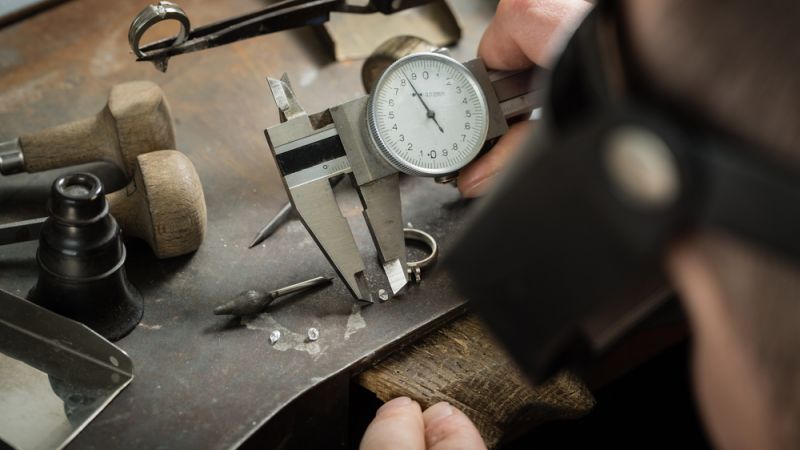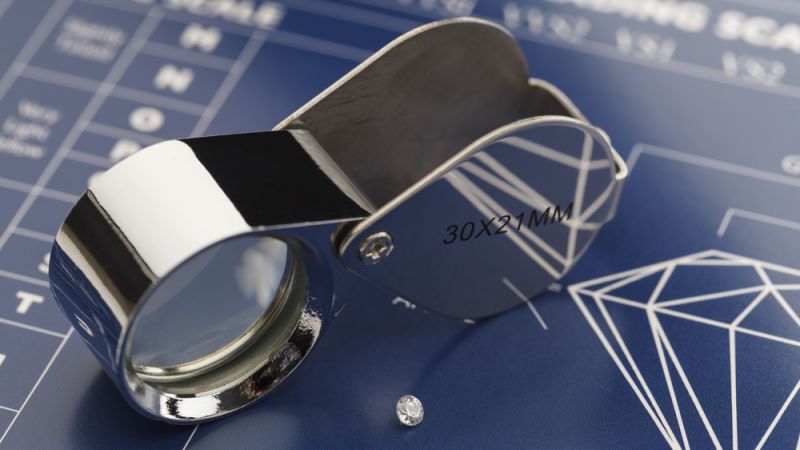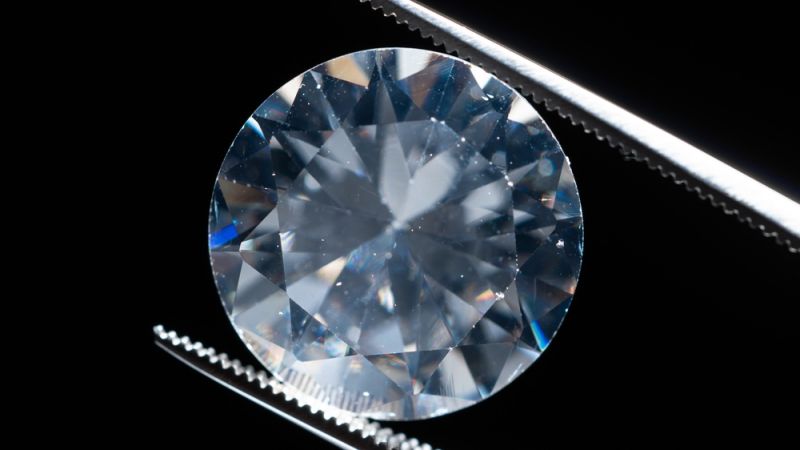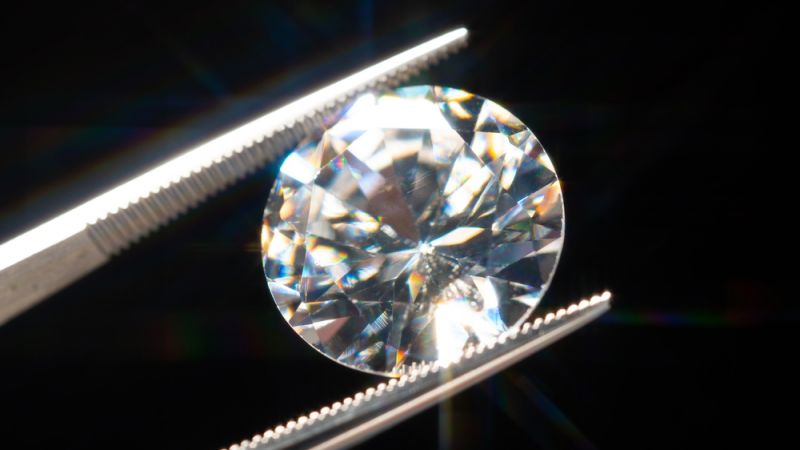When considering the purchase of a diamond, it is important to consider various factors known as the four Cs: cut, carat, color, and clarity. However, there are additional aspects that contribute to a diamond’s beauty and appearance, such as diamond depth and table percentage.
Understanding the significance of diamond depth and table is crucial in evaluating a diamond’s overall quality. To gain a comprehensive understanding of these factors and learn what to focus on, continue reading this article until the end.
DESIGN YOUR OWN ENGAGEMENT RING: START WITH A SETTING OR START WITH A DIAMOND. IT’S REALLY UP TO YOU!

What Is Diamond Depth?
When considering a diamond purchase, the cut of the diamond is often given the most attention among the four Cs. This is because the cut has a significant impact on the diamond’s overall appearance. The cut of a diamond affects its appearance in three important ways: brilliance (brightness of reflected and refracted light), fire (dispersion of light into visible colors), and scintillation (sparkle when the diamond is moved).
Diamond depth plays a crucial role in determining a diamond’s brilliance, fire, and scintillation. Depth refers to the height of the stone measured from the table to the culet, typically in millimeters. The culet is the bottom tip of the diamond, not visible to the naked eye, while the table is the largest facet on the top of the diamond.
The depth of a diamond influences how light travels through the stone and affects the amount of light reflected back to the viewer. Shallow diamond cuts allow light to pass through quickly without creating reflections, while excessively deep cuts can result in poor sparkle and make the diamond appear smaller than it actually is.
Selecting a diamond with an ideal depth is important because it allows maximum light to pass through the stone, striking each facet of the pavilion and reflecting back to the viewer’s eyes.
The ideal depth of a diamond varies based on its shape and cut, and it is usually indicated on a diamond grading report. The report provides two depth measurements: total height in millimeters and depth percentage.
To calculate the depth percentage, divide the total height of the diamond by its average diameter and multiply the result by 100. This percentage indicates the diamond’s depth relative to its diameter.
While there is no universally ideal depth for diamonds, there are recommended depth ranges for popular diamond shapes. It is helpful to consider these ranges when shopping for a diamond.
| Diamond Shape | Ideal Depth Percentage Range (%) |
|---|---|
| Round Brilliant Cut Diamonds | From 59 to 62.6 |
| Radiant Cut Diamonds | Less than 67 |
| Princess Cut Diamonds | From 68 to 75 |
| Pear-shaped Diamonds | Less than 68 |
| Oval Cut Diamonds | Less than 68 |
| Marquise-Cut Diamonds | From 58 to 62 |
| Heart-shaped Diamonds | From 56 to 62 |
| Cushion Cut Diamonds | From 61 to 68 |
| Emerald Cut Diamonds | From 61 to 68 |
As previously mentioned, the depth of a diamond is crucial when searching for the perfect gem. But how can you utilize this important aspect during your diamond shopping experience?
First, you need to determine the diamond cut you desire. For instance, if you’re interested in a round brilliant cut, you should request the seller to present several round brilliant cut diamonds that match your preferences.
Next, visually examine the diamonds to ensure they possess the physical characteristics you’re seeking. Among the four Cs, evaluating the diamond cut is often the most challenging.
To confirm that you’re obtaining a well-cut diamond, ask for a diamond grading report. Look for the diamond depth percentage assigned to the specific round brilliant cut diamond you intend to purchase.
Upon careful review of the diamond grading report, if you find that the diamond depth percentage falls between 59% and 62.6%, you can confidently conclude that the stone has been impeccably cut.
Conversely, if the diamond depth percentage falls outside the recommended range, it indicates a suboptimal cut, potentially resulting in a diamond with less brilliance and sparkle.

What Is A Diamond Table?
The diamond table, which is the flat, square-shaped top facet of a diamond, plays a crucial role in the structure of the gemstone.
Functionally, the diamond table refracts the light rays that enter the diamond and directs them to different facets, influencing the diamond’s brilliance, fire, and scintillation, much like the diamond depth.
The size of the diamond’s table is a significant factor in its appearance. It is often misunderstood that a larger table leads to better light handling. However, this is not always the case. If the table is too large, the upper facets may not effectively disperse light. Conversely, if the table is too small, the amount of light entering the diamond decreases, affecting its brilliance.
So, what is the ideal size for a diamond table?
Naturally, larger diamonds tend to have proportionally larger tables and higher table percentages. However, the relationship between table size and the overall diamond may vary based on the cutting and faceting techniques employed. Customers often have to consider the trade-off between brilliance and fire when choosing a suitable table size for their diamonds.
Jewelers rely on table percentages rather than table size when grading diamonds, as it accounts for variations in physical size. The diamond grading report assigns a score between Excellent and Poor for the table size, while the table percentage is indicated numerically.
According to the Gem Society, the ideal table percentage typically falls between 52% and 62%. However, it is important to note that individual preferences and the overall size and shape of the diamond can influence the ideal percentage range.
To calculate the table percentage, divide the table width by the total width of the diamond and multiply the result by 100. For instance, if the table width is 10 millimeters and the total width is 7.5 millimeters, the table percentage would be calculated as follows:
Table width/total width x 100
10/7.5 = 0.75
0.75 x 100 = 75%
The table below provides the ideal diamond percentage ranges for popular diamond cuts:
[Insert table with ideal diamond percentage ranges for popular diamond cuts]
| Diamond Shape | Ideal Table Percentages (%) |
|---|---|
| Round Brilliant Cut Diamonds | From 53 to 58 |
| Radiant Cut Diamonds | From 61 to 69 |
| Princess Cut Diamonds | From 67 to 72 |
| Pear-shaped Diamonds | From 53 to 63 |
| Oval Cut Diamonds | From 53 to 63 |
| Marquise-Cut Diamonds | From 53 to 63 |
| Heart-shaped Diamonds | From 53 to63 |
| Cushion Cut Diamonds | From 61 to 67 |
| Emerald Cut Diamonds | From 61 to 69 |
Analyzing the table values in the provided table, you’ll notice that the variations may appear small, but they have a significant effect on the overall appearance of the diamond.
Just like the diamond depth, having a clear understanding of the recommended diamond table percentage for a specific diamond shape is crucial when you’re in the market for a diamond.

How To Select The Perfect Depth And Table Sizes?
It’s important to understand that among the four Cs, the diamond cut is the most intricate aspect to evaluate. Sometimes, what may appear as a round shape to the naked eye could actually be an oval shape. Additionally, recognizing various diamond shapes doesn’t necessarily mean being able to assess the technical details of the diamond’s facets. This is where depth and table percentages come into play.
As a buyer, it’s crucial to ensure that the diamond you’re purchasing comes with a diamond grading report issued by a reputable grading lab such as GIA or AGS. These reports often include information about the diamond’s depth and table percentages, among other details.
Before examining the depth and table measurements, carefully review the diamond grading report and understand its cut grade. The depth and table percentages are finer elements of the diamond’s cut, so it’s important to determine if the diamond meets your desired cut grade.
One advantage of ideal depth and table percentages is that they don’t significantly impact your budget. Since these values are expressed as percentages, they remain consistent regardless of the diamond’s weight, clarity, or color. This means that a 0.8-carat diamond can have similar light-handling properties as a 10-carat diamond, given that their depth and table percentages are similar and other factors are kept constant.

Why Should You Select Depth And Table Correctly?
The depth and table percentages of a diamond play a crucial role in determining its light performance. These factors directly affect the diamond’s brilliance, fire, and scintillation, which ultimately contribute to its overall sparkle. Considering the significance of appearance when purchasing jewelry, it is vital not to overlook these critical aspects.
Moreover, selecting the appropriate depth and table percentages also has an impact on the diamond’s price. Jewelers frequently take these seemingly minor details into account when pricing their gemstones. It is not uncommon to find two diamonds with similar characteristics, yet their depth and table ratings result in different price tags.

Bottom Line
The diamond depth and table ratings serve as helpful guidelines for customers in choosing their desired diamonds. However, it’s important to remember that while these parameters are valuable, there are other quality factors to consider when selecting a diamond.
Ultimately, your personal preference and taste play the most significant role. If a diamond appeals to you and meets your visual standards, it becomes the perfect choice, regardless of specific depth and table ratings.


